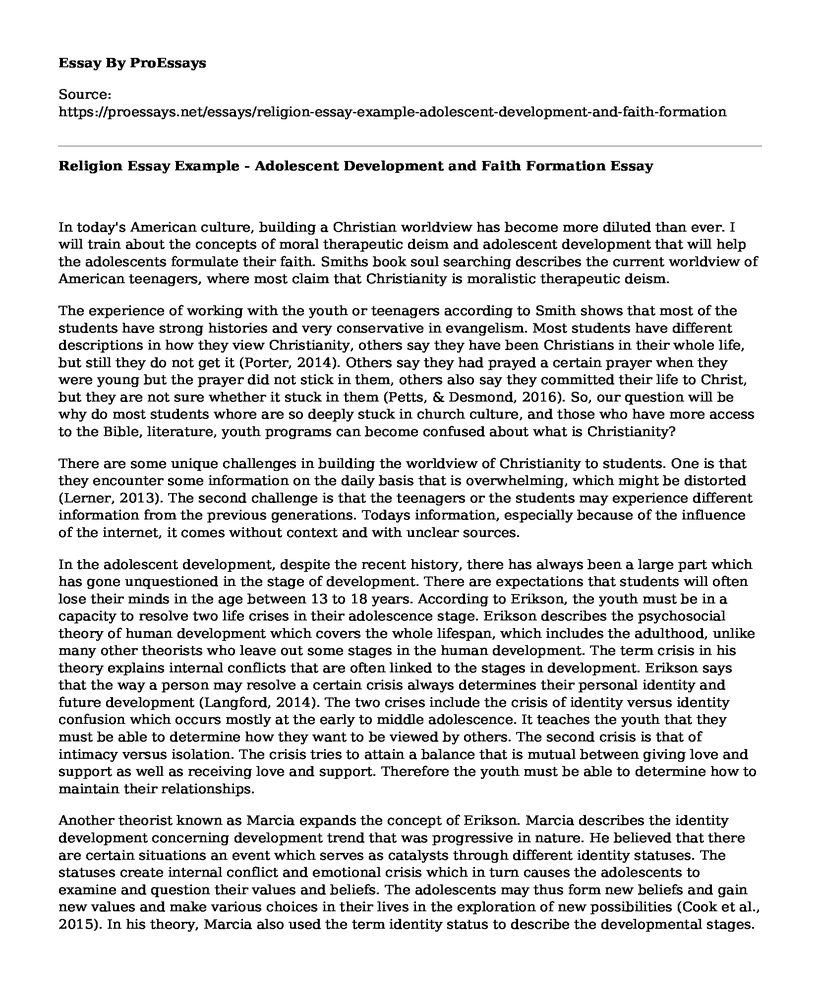In today's American culture, building a Christian worldview has become more diluted than ever. I will train about the concepts of moral therapeutic deism and adolescent development that will help the adolescents formulate their faith. Smiths book soul searching describes the current worldview of American teenagers, where most claim that Christianity is moralistic therapeutic deism.
The experience of working with the youth or teenagers according to Smith shows that most of the students have strong histories and very conservative in evangelism. Most students have different descriptions in how they view Christianity, others say they have been Christians in their whole life, but still they do not get it (Porter, 2014). Others say they had prayed a certain prayer when they were young but the prayer did not stick in them, others also say they committed their life to Christ, but they are not sure whether it stuck in them (Petts, & Desmond, 2016). So, our question will be why do most students whore are so deeply stuck in church culture, and those who have more access to the Bible, literature, youth programs can become confused about what is Christianity?
There are some unique challenges in building the worldview of Christianity to students. One is that they encounter some information on the daily basis that is overwhelming, which might be distorted (Lerner, 2013). The second challenge is that the teenagers or the students may experience different information from the previous generations. Todays information, especially because of the influence of the internet, it comes without context and with unclear sources.
In the adolescent development, despite the recent history, there has always been a large part which has gone unquestioned in the stage of development. There are expectations that students will often lose their minds in the age between 13 to 18 years. According to Erikson, the youth must be in a capacity to resolve two life crises in their adolescence stage. Erikson describes the psychosocial theory of human development which covers the whole lifespan, which includes the adulthood, unlike many other theorists who leave out some stages in the human development. The term crisis in his theory explains internal conflicts that are often linked to the stages in development. Erikson says that the way a person may resolve a certain crisis always determines their personal identity and future development (Langford, 2014). The two crises include the crisis of identity versus identity confusion which occurs mostly at the early to middle adolescence. It teaches the youth that they must be able to determine how they want to be viewed by others. The second crisis is that of intimacy versus isolation. The crisis tries to attain a balance that is mutual between giving love and support as well as receiving love and support. Therefore the youth must be able to determine how to maintain their relationships.
Another theorist known as Marcia expands the concept of Erikson. Marcia describes the identity development concerning development trend that was progressive in nature. He believed that there are certain situations an event which serves as catalysts through different identity statuses. The statuses create internal conflict and emotional crisis which in turn causes the adolescents to examine and question their values and beliefs. The adolescents may thus form new beliefs and gain new values and make various choices in their lives in the exploration of new possibilities (Cook et al., 2015). In his theory, Marcia also used the term identity status to describe the developmental stages. These are; identity diffusion, foreclosure, achievement, and identity moratorium. Each of the statuses represents a particular configuration in the youth development regarding their beliefs, values, and goals that contribute to identity.
In conclusion, it can be seen that it's hard to separate the development of identity from personal values and beliefs. Adolescents will experience both success and failures along their way as they interact with others. Different approaches to the youth ministry will often sanctify adolescence.
References
Cook, K. V., Kimball, C., Boyatzis, C. J., & Leonard, K. C. (2015). Religiousness and spirituality among highly religious emerging adults. Journal of Psychology & Christianity, 34(3).Langford, M. D. (2014). Spirit-driven discipleship a pneumatology of youth ministry. Theology Today, 71(3), 323-336.
Lerner, R. M. (2013). Kenda Creasy Dean, Almost Christian: What the Faith of our teenagers is telling the American Church (New York: Oxford University Press, 2010), pp. 254. $24.95. Scottish Journal of Theology, 66(02), 246-248.
Porter, N. D. (2014). Family, peers, and religious communities in the formation of adolescent religious identity (Doctoral dissertation, The Pennsylvania State University).Petts, R. J., & Desmond, S. A. (2016). Adolescence and emerging adulthood. In Handbook of Religion and Society (pp. 241-262). Springer International Publishing.
Cite this page
Religion Essay Example - Adolescent Development and Faith Formation. (2021, Mar 31). Retrieved from https://proessays.net/essays/religion-essay-example-adolescent-development-and-faith-formation
If you are the original author of this essay and no longer wish to have it published on the ProEssays website, please click below to request its removal:
- Discussion on how Parenting Styles and Attachment Impact the Development of a Child
- Essay Sample on The Difference Between Negative and Positive Freedom
- The Black Movement - Research Paper
- Fetal Abortion Christian View Essay Example
- Essay on Social Support Theory: Understanding Traumatic Situations and Emotional Attachments
- Assignment Example on Body Language as Part of Communication
- Free Essay Sample on Same-Sex Marriage in the US







